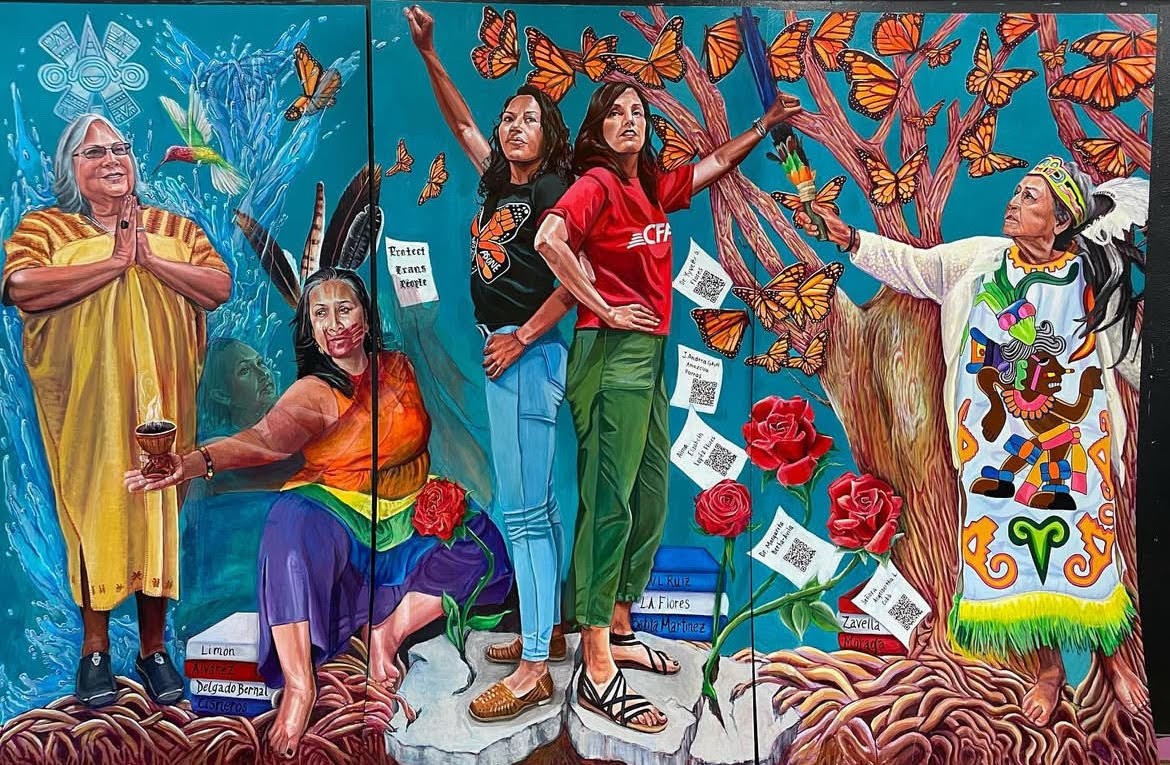November is Native American Heritage Month throughout the United States. American River College, to its credit, has made strides to support the indigenous peoples of the region, such as the Nisenan, Maidu and Miwok tribes. Yet actions such as land acknowledgement may not be sufficient.
ARC has made great efforts promoting inclusion and diversity as a matter of principle. Last year, federal funding was secured for Hispanic serving institutions by ARC for the purpose of promoting engagement and representation for Hispanic students. Recent overtures by the ARC administration has encouraged legislation for further federal funding to Black serving institutions for promoting engagement and representation of African American students.
These successes are positive inclusionary policies for the myriad of different backgrounds present at ARC. Their promotion, however, is ingrained within a colonial system whose very foundation is based on a concept that upward mobility can only be achieved through assimilation.
For the indigenous peoples of America, assimilation requires the extinction of their way of life. Indigenous students and faculty at ARC see these attempts of assimilation as dilution of their tribal culture, and thus grounded in colonial precedent. The only way that the ARC administration and student senate can hope to make things right by ARC’s indigenous population would be to treat the unique characteristics of native tribal hierarchies in a different manner, unique and removed from their other minority serving institution policies.
This can only be achieved with more direct involvement with indigenous peoples, as their experience is more unique than may be understood. Moreover, the only way to culturally decolonize is to adjust the relationship of sovereignty, and to treat tribal affairs as equal to administrative affairs.
“The United States machine in and of itself is intended to absorb, assimilate, and unify under what is called an imagined community, so everyone is an American,” said Jesus Valle, director of ARC’s Native American Resource Center in an interview with The Current.
It’s difficult to understand the nuanced relationship between the colonizer and the native peoples, since history shows that efforts such as dual sovereignty inevitably fail to reach political equality.
The American idea is based upon the concept that all people are created equal, however in the case of indigenous Americans, this ideal is ignored as it doesn’t fit within the traditional American political framework.
For this reason, the sovereignty of indigenous Americans will remain a charity offered by the white man, rather than an inalienable right.
At ARC, the legacy of these actions and the apologist attitude towards the crimes of the past are omnipresent in the rules and regulations that dictate the behavior of the governing bodies.
Carol Goodin was acting tribal elder when members of the Native Club pursued the approval of a resolution during an ARC Associated Student Body meeting back in May, and during the ASB meetings regarding this resolution, she spoke on behalf of the group as a whole. Goodin is of mixed native and Scot/Irish descent and grew up in a tent in Oklahoma. She later became a pharmacist on reservations for several decades before enrolling as a student at ARC.
Speaking on the subject of the resolution still being negotiated back in March, Goodin expressed her dismay in how few resources are allocated for native support.
“There are a large number of native students at ARC, and we’re in this tiny little space here inside of this UNITE organization,” Goodin said. “Why is this large population under-resourced, understaffed, and under-acknowledged?”
The Current was present at several meetings between the ARC ASB and members of the ARC Native Club as they worked to finalize the “Nothing About Us Without Us” ASB resolution, wherein ASB would support tribal consultation in matters pertaining to Indigenous Americans at ARC.
These initial conversations were tense. The members of the indigenous community said they felt as if they were being forced to address trauma that their people had dealt with since their introduction to white people centuries ago. During this ASB meeting, they had felt that these traumas were compounded throughout the continued dismissal of their sovereignty. The ASB, on the other side of the dais, expressed the desire to work with the Native Club within the parameters that their constitution allows.
The ASB members, to their credit, said they weren’t aware that they had been exacerbating these traumas, as the structure of their senatorial system encouraged open dialogue among all present parties. This was not the way that the tribal representatives intended to engage with the ASB, nor was it prepared for their representation to be cast into scrutiny.
Whether this unfamiliarity to tribal hierarchies is the fault of anyone specifically is a moot point. What this unfamiliarity displays is the existing conflict of representation within American democratic traditions. When the student senators, whose experience in governance is only with American political traditions, find themselves speaking across the bargaining table with tribal representatives with limited success.
The ASB members said they didn’t realize that they were supposed to speak directly with the tribal elder as the standing representative of the indigenous community. On both sides of the dais, their traditional methods of governance aren’t bugs, they’re features. Features that don’t align with one another as they struggle to achieve cohesion on the resolution.
Had they been speaking to one another on an equal platform, seeing as the structure of their political and representational systems are so different, there may have been equal allowances afforded mutually on either side. Historically as well as contemporarily, this isn’t the case. Whereas the tribal elder may have a comprehensive understanding of senatorial procedure, the same understanding is not reciprocated by the senate.
Attempts to bridge these gaps will inevitably fall flat as the relationship with each other’s sovereignty displays that the American system retains dominance. This dominance is baked into American institutions where constitutions, treaties and edicts aren’t designed to offer leverage to competing governing bodies. While the ASB operates under a constitution authorized by the Los Rios District Board of Trustees, tribal representation lacks such a charter.
The governing power is only inclined to distribute resources in situations that are supported by that power, all else is ignored. When speaking on the subject of race-based resource allocation, Valle expressed this concern regarding the impetus behind the Hispanic serving institution as well as the Asian American, Native American and Pacific Islander serving institution measures and funding.
“When you look at large-scale kinds of race-based initiatives, it’s really looking at Anglo serving, primarily white institutions and Hispanic serving [institutions] as two wings of the same bird,” Valle said. “All of these race-based groups are seeking social justice, but they’re doing so at the expense of tribalism and tribal people.”
With all of these critiques being leveled, the Los Rios Community College District, the state of California and the U.S. federal government isn’t simply a tone deaf group of conspirators hell bent on the destruction of all things indigenous, however.
In 1990, the U.S. federal government put into law the Native American Graves Protection and Repatriation Act which legally codifies the protection and return of Native American human remains, funerary objects, sacred objects, and objects of cultural patrimony. The LRCCD, working in concert with Sacramento area tribes, expects to be within full compliance of the law by January 2026. Although tangible objects like indigenous human remains found at ARC offer hope for reconciliation, the ghosts of native ancestors have little influence in changing the colonial traditions that remain firmly planted in the soil of U.S. social constructs.
U.S. Public Law 93-638, which came into effect in 1996 as an amendment to the Indian Self-Determination and Education Assistance Act of 1975, is vague in its definition of self-determination contracts. The Department of Indian Affairs rulemaking committee established for this act. Subpart F of this act states:
“Indian self-determination contracts are unique agreements because, by definition, they are not procurement contracts, discretionary grants or cooperative agreements.”
The act goes on to express how the unique parameters of self-determining contracts are open to interpretation.
“The absence of established guidelines presented a special challenge to the committee to develop standards which would assure appropriate stewardship of the Federal funds and other assets being transferred through these contracts.”
Even among the highest regulatory bodies in the land, and the powers that establish the policies that govern institutions like the Los Rios Community College District, they may find it difficult to accurately define the relationship between U.S. governmental bodies and tribal political organizations.
What may offer some form of solace for native students at ARC is that ARC is in the process of hiring a native historian, as discussed during an Oct. 25 ASB meeting by senate committee members of the “Nothing About Us Without Us” committee. What this means for indigenous representation, however, is difficult to predict. The resolution was a contentious row that eventually led to the resolution by the ASB which encouraged inclusion of native students in their own affairs. Moreover, the Native Club achieved additional representation by receiving authorization to install an indigenous student as a hiring consultant on indigenous ARC faculty and employees moving forward. The resolution and its ramification have produced a noticeable result on the hiring process of ARC employees involved in indigenous programs.
ARC recently hired Ignacio Taylor, himself of native descent, to begin his tenure at ARC as native historian. Taylor was hired under the observation of the native consultant, which has now been included in the hiring discussion. That consultant was Goodin herself, and her induction in this role took place during the discussions over the resolution.
The resolution and representation in the hiring process are yet another example of sovereignty by the dominant American governing culture. Only through aggressive campaigning by members of the Native Club did involvement become a priority.
As ARC, LRCCD, and the institutions they manage attempt to promote the sovereignty of the native peoples that walk among them, they do so without the capacity to grant self-determination. The term “Nothing About Us Without Us” is a principle policy that indigenous people use to express the desire to determine their own fate, but the self-determination offered could be robbed from Indigenous people if the American government decides they are not playing by their established rules.
There are steps that can be taken by people on a personal level to support local Native peoples, as recommended by the Native Club of ARC. Allies of the Indigenous cause can learn whose land they currently occupy with an interactive map. They can familiarize themselves with native flora, and cultivate such plants to act as more hospitable tribal land stewarts. They can provide meals, textbooks, supplies, gifts and tutoring for native students to empower their education. They can learn more about the plight of Indigenous peoples, both locally and throughout the continent. They can reach out to their political representatives to encourage a more prosperous environment for Indigenous peoples.
The key throughline in an ally’s efforts is through behavior and actions that demonstrate that Indigenous sovereignty isn’t just a talking point, but a necessity.








